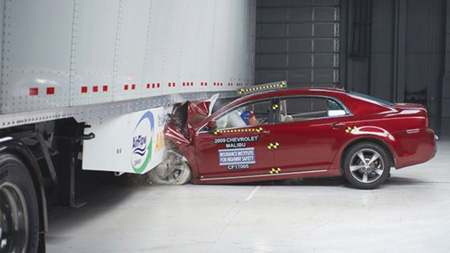

August 29, 2017
RUCKERSVILLE, Va. — An aftermarket device that attaches to the sides of a tractor trailer successfully prevented a midsize car from sliding underneath the trailer in a 40 mph crash test conducted by the Insurance Institute for Highway Safety.
It was the second time IIHS had tested the AngelWing device produced by Airflow Deflector Inc. The first test was conducted at 35 mph. Researchers decided to see if the side guard would hold up at 40 mph, the speed at which IIHS conducts its frontal crash tests of passenger cars. A 40 mph crash involves 30 percent more energy than a 35 mph crash.
The latest test was conducted during the Institute’s second roundtable on the problem of truck underride crashes. It was held at the IIHS Vehicle Research Center and cosponsored by the Truck Safety Coalition and AnnaLeah and Mary for Truck Safety.
The event brought together safety advocates, researchers, government officials and industry leaders to discuss ways to make it safer for passenger vehicle occupants and other road users to share the road with large trucks.
Underride occurs when a smaller vehicle crashes into a truck and goes completely or partially underneath it, increasing the likelihood of serious injuries to people riding in the smaller vehicle.
Tractor-trailers are required under federal regulations to have underride guards on their rears, but not on their sides. Of the 1,542 deaths of passenger vehicle occupants in crashes with tractor-trailers in 2015, 301 involved the side of a tractor-trailer compared with 292 that involved the rear.
“Our tests of the AngelWing show that measures to reduce the side underride problem are within reach,” says David Zuby, IIHS executive vice president and chief research officer. “Broader use of devices like this one, combined with continued improvements to rear underride guards, would go a long way toward reducing deaths in large truck crashes.”
In Tuesday’s test, a 2009 Chevrolet Malibu struck the center of a 53-foot long dry van trailer at 40 mph. The outcome was similar to the 35 mph test with the AngelWing.
The side guard bent but didn’t allow the car to go underneath the trailer, and the car’s airbags and safety belt properly restrained the dummy in the driver seat. Measures taken from the dummy showed there would be a low likelihood of injuries in a similar real world crash.
In contrast, in a second 35 mph test conducted earlier this year with no side guard, the Malibu ended up lodged under the trailer with part of its roof torn off. In a real crash like that, there would likely be no survivors in the car.
The AngelWing is a result of a collaboration that came out of the first underride roundtable held in May 2016 at the Vehicle Research Center. It was there that Airflow Deflector President Robert Martineau met Perry Ponder, president of Seven Hills Engineering, who had developed a design for a side underride guard. Together, they modified Ponder’s invention and brought it into production.

The AngelWing’s structure as seen from the opposite side of the trailer from the crash.
While side guards that can prevent passenger vehicle underride are relatively new, lighter weight guards to protect bicyclists and pedestrians are more common. At least three U.S. cities — Boston, New York and Seattle — require such guards on city owned or contracted trucks as part of their Vision Zero initiatives.
Side underride guards were the focus of Tuesday’s roundtable which also touched on progress in addressing rear underride and the role of crash avoidance technologies in reducing underride fatalities.
“When people talk about Vision Zero, often what comes to mind is the potential for self driving vehicles to eliminate crashes entirely,” says David Harkey, who directs the University of North Carolina Highway Safety Research Center and delivered the roundtable’s keynote.
“While technology holds a lot of promise, it’s going to take a long time to get there. There are things we can do now to save lives, and side underride guards are a perfect example.”
Making rear underride guards more effective is another improvement that would be relatively easy to accomplish today. IIHS research has shown that guards meeting the federal standard don’t always do a good job of preventing underride, particularly when the smaller vehicle hits the rear of the truck off center.
IIHS conducts tests of rear guards, crashing a midsize car into the back of a tractor-trailer in three different configurations. Manufacturers of trailers that prevent underride in all three tests earn the IIHS TOUGHGUARD award.
Utility Trailer Manufacturing Co. recently became the sixth manufacturer to earn the award. Of the eight largest manufacturers, only Hyundai Translead and Strick Trailers LLC have yet to qualify.
Trailers from both companies have passed the full width and 50 percent overlap test but so far have failed to keep the car from traveling underneath the trailers in the 30 percent overlap test. However, the two companies have new designs that they expect will pass, and IIHS plans to evaluate them later this year.